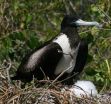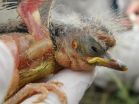(Press-News.org) Although the magnificent frigatebird may be the least likely animal on the Galapagos Islands to be unique to the area, it turns out the Galapagos population of this tropical seabird may be its own genetically distinct species warranting a new conservation status, according to a paper by researchers at the Smithsonian Conservation Biology Institute, the Smithsonian's National Museum of Natural History and the University of Missouri-St. Louis published last week in the scientific journal Proceedings of the Royal Society B.
The Galapagos Islands, which once served as a scientific laboratory for Charles Darwin, boast a number of unique plant and animal species, from tortoises to iguanas to penguins. Magnificent frigatebirds, however, can fly hundreds of kilometers across open ocean, suggesting that their gene flow should be widespread and their genetic make-up should be identical to those of the magnificent frigatebirds on the mainland coast of the Americas. Even Darwin predicted that most Galapagos seabirds would not be very different from their mainland counterparts. But researchers at SCBI conducted three different kinds of genetics tests and all yielded the same result—the Galapagos seabirds have been genetically different from the magnificent frigatebirds elsewhere for more than half a million years.
"This was such a surprise," said Frank Hailer, a postdoctoral research associate at SCBI and lead author of the paper. "It's a great testimony to just how unique the fauna and flora of the Galapagos are. Even something that is so well-adapted to flying over open oceans is isolated there."
Scientists began the research to determine whether the magnificent frigatebird on the Galapagos was more similar genetically to the magnificent frigatebirds on the Caribbean side or the Pacific side of the islands. Using frigatebird samples from Betty Anne Schreiber at the National Museum of Natural History, Iris Levin and Patricia Parker at the University of Missouri-St. Louis and those they collected in the field, SCBI researchers determined that the Galapagos version differ not only genetically, but also morphologically.
Now scientists are left with a number of questions: Are the genetics of the magnificent frigatebird on the Galapagos different enough to classify it as a distinct species? And what, exactly, accounts for the genetic and morphological differences when the seabirds can travel far and wide and therefore should not be isolated to one area to reproduce? SCBI and National Museum of Natural History researchers plan to collaborate with others in the field to find the answers.
What is clear, however, is that this small population of genetically unique magnificent frigatebirds is a vulnerable population. Any catastrophic event or threats by humans could wipe out the approximate 2,000 magnificent frigatebirds that nest on the Galapagos Islands.
"The magnificent frigatebirds on the Galapagos are a unique evolutionarily significant unit, and if the Galapagos population did go extinct, the area will not likely be recolonized rapidly by mainland birds," said Robert Fleischer, head of SCBI's Center for Conservation and Evolutionary Genetics and one of the paper's co-authors. "This emphasizes the importance of protecting this small population of birds there."
Magnificent frigatebirds are currently considered of least concern by the International Union for Conservation of Nature, but the Proceedings of the Royal Society B paper recommends that, because of the genetic uniqueness of those on the Galapagos, this status be revisited.
INFORMATION:
Authors of the paper: Frank Hailer, Smithsonian's National Zoo; E. A. Schreiber, Smithsonian's National Museum of Natural History; Joshua Miller, Smithsonian's National Zoo; Iris Levin, University of Missouri-St. Louis; Patricia Parker, University of Missouri-St. Louis; Terry Chesser, U.S. Geological Survey and Smithsonian's National Museum of Natural History; and Robert Fleischer, Smithsonian's National Zoo.
Smithsonian researchers find differences between Galapagos and mainland frigatebirds
2010-09-29
ELSE PRESS RELEASES FROM THIS DATE:
The dual nature of dew
2010-09-29
When the scientific and spiritual worlds collide, they do so in the most surprising ways. Classical meteorological and plant science has, in the last century, insisted that dew negatively affects plant life, leading to rot and fungus. But in the Judeo-Christian tradition, dew is most welcomed as an important source of vegetative and plant life, celebrated in poetry and prayer.
Now Prof. Pinhas Alpert of Tel Aviv University's Department of Geophysics and Planetary Sciences has developed an explanation for the perplexing paradox with his colleagues. According to scientific ...
Noise and chemicals: Workers are losing their hearing
2010-09-29
A study carried out by Spanish researchers has shown that the presence of chemical contaminants can interact with noise and modify, for good or for bad, the way in which work-related "deafness" – which is increasingly common among young people – manifests itself. Noise-related hearing loss is the most common occupational disease in Europe.
"Workers exposed to noise in the presence of metalworking fluids exhibit a delay in hearing alteration in comparison with those exposed only to noise at the same intensity. However, those exposed to noise in the presence of welding ...
Truthy.indiana.edu to search, identify smear tactics, Twitter-bombs through election runup
2010-09-29
Astroturfers, Twitter-bombers and smear campaigners need beware this election season as a group of leading Indiana University information and computer scientists today unleashed Truthy.indiana.edu, a sophisticated new Twitter-based research tool that combines data mining, social network analysis and crowdsourcing to uncover deceptive tactics and misinformation leading up to the Nov. 2 elections.
Combing through thousands of tweets per hour in search of political keywords, the team based out of IU's School of Informatics and Computing will isolate patterns of interest ...
Immunization coverage key to good health locally, globally
2010-09-29
FORT WORTH, TEXAS, USA, September 28, 2010—The outbreak of whooping cough in Texas, California, and other states this year underscores the critical importance of widespread vaccination coverage, both locally as well as around the world, said a leading global health official attending conferences on world affairs and immunization in Fort Worth this week.
Alex Palacios, a special representative of the GAVI Alliance, a public-private partnership aimed at increasing immunisation rates in poor countries, said that despite public health advances in the US and other wealthy countries ...
Tracking down pathogenic yeasts
2010-09-29
More than half of all people are hosts to Candida albicans in their bodies. This species might be located on their skin or mucous membranes or in the intestines – frequently without causing any symptoms. However, it can be dangerous to patients whose immunological system has been weakened such as after organ transplants or chemotherapy with cancer. Then, this fungus penetrates into deeper layers of tissue and uses the blood system to spread throughout the body. In Germany alone, several thousand people die from systemic candida infections every year.
But why does Candida ...
Understanding Missouri River's sediment dynamics key to protecting endangered species
2010-09-29
Sept. 28, 2010 -- A new report from the National Research Council says that more organized and systematic procedures for gathering and evaluating data on Missouri River sediment are required to improve decisions and better manage the river's ecosystem, including protecting endangered species and developing water quality standards. In addition, the report finds that the U.S. Army Corps of Engineers' projects to restore habitats along the Missouri River are not significantly changing the size of the oxygen-depleted "dead zone" in the Gulf of Mexico, nor will options for ...
Wheel in a corset
2010-09-29
Just imagine your car suddenly comes to a halt on a quiet country road, and it's only four years old. This is not a pleasant thought. A breakdown is expensive. Not to mention the safety risk to the occupants – because the breakdown was caused by the extremely light plastic wheels so highly praised by the car salesman. One of them has broken. »Such a scenario must, of course, never happen in reality,« states Prof. Dr.-Ing. Andreas Büter from the Fraunhofer Institute for Structural Durability and System Reliability LBF in Darmstadt. The experts there specialize in operational ...
Study finds potential climate change side effect: More parasites on South American birds
2010-09-29
A Wildlife Conservation Society (WCS) study on nesting birds in Argentina finds that increasing temperatures and rainfall—both side effects of climate change in some parts of the world—could be bad for birds of South America, but great for some of their parasites which thrive in warmer and wetter conditions.
The study, which looked at nesting forest birds in Santa Fe, Argentina, found that increases in temperature and precipitation produce a bumper crop of parasitic fly larvae of the species Philornis torquans, parasites that burrow into the skin of baby birds to feed. ...
Why we fight: Men check out in stressful situations
2010-09-29
A new study by USC researchers reveals that stressed men looking at angry faces had diminished activity in the brain regions responsible for understanding others' feelings.
Turns out the silent and stoic response to stress might be a guy thing after all.
"These are the first findings to indicate that sex differences in the effects of stress on social behavior extend to one of the most basic social transactions — processing someone else's facial expression," said Mara Mather, director of the Emotion and Cognition Lab at USC.
In an article appearing the October 6 issue ...
Assessment of US doctoral programs released, offers data on more than 5,000 programs nationwide
2010-09-29
Sept. 28, 2010 — The National Research Council today released its assessment of U.S. doctoral programs, which includes data on over 5,000 programs in 62 fields at 212 universities nationwide. The assessment is designed to help universities evaluate and improve the quality of their programs and to provide prospective students with information on the nation's doctoral programs. (See Full Report)
"This report and its large collection of quantitative data will become in our view an important and transparent instrument for strengthening doctoral education in the United States," ...





